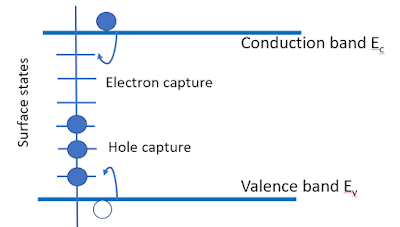Introduction
The electron present in the conduction band is in a meta-stable state and stabilized to a lower energy position in the valence band. When the electron stabilizes back down to the valence band, it effectively removes the hole. Eventually, electrons lose energy and stabilize back to the valence band, recombining with a hole. In a bulk semiconductor, recombination acts to restore the non‐equilibrium light generated electron-hole pair (EHP) population to its thermal equilibrium value. Among the factors recombination is associated with the lifetime of the component or PV cell.
Types of Recombination
1. Radiative Recombination
2. Non‐Radiative (Shockley‐Read‐Hall) Recombination
4. Auger Recombination
5. Surface, Interface, and Grain Boundary Recombination
1. Radiative Recombination
Radiative recombination is a recombination of the electron in the conduction band with a hole in the valence band, resulting in photon emission at bandgap energy(Eg). This type of recombination mechanism is dominant in direct bandgap semiconductors. The most obvious example of radiative recombination in a semiconductor device is light produced from a light-emitting diode (LED). Space solar cells and Concentrator are generally made from direct bandgap materials (GaAs etc.), and radiative recombination dominates. But, terrestrial solar cells are made from silicon, an indirect bandgap semiconductor, and radiative recombination is extremely low and usually neglected.
 |
| Fig: Radiative Recombination |
The radiative recombination of the carrier can provide the ultimate limit to device efficiency.
2. Non‐Radiative (Shockley‐Read‐Hall) Recombination
Growing extremely pure semiconductors is difficult. The practical semiconductor may contain certain degree impurities or vacancies incorporated into crystal structure during the material growth process. These impurities lead to localized defect levels within the bandgap of bulk semiconductors, which are often referred to as trap states due to the availability of the level of spatially capture a delocalized free carrier. This type of trap assists non-radiative recombination is often the practical limiting loss mechanism in most solar cells.
The trap located near the center of the bandgap is sometimes called a recombination center.
The recombination center can capture electron from the conduction band followed by hole capture from the valence band. This significant recombination event is most often non-radiative, with the capture energies being emitted as Phonons.
3. Auger Recombination
Three carriers are directly involved in the Auger Recombination. This type of recombination is a non-radiative recombination process where the energy of the photo-generated carrier is dissipated not by photon emission at energy bandgap (Eg) but rather by increasing the kinetic energy of another free carrier shown in fig below.
When electron-hole recombines, energy is given to a third carrier, an electron in the conduction band. This electron then thermalizes back down the conduction band edge by emitting energy capture as phonons.
 |
| Fig: Auger Recombination |
Auger recombination is most important when there are heavily doped carrier concentrations or high-level injection under concentrated sunlight. In silicon-based solar cells (the most popular), Auger recombination limits the lifetime and ultimate efficiency. The more heavily doped the material is, the shorter the Auger recombination lifetime.
4. Surface, Interface, and Grain Boundary Recombination
At the surface of a solar cell, dangling un-passivated bonds and absorbed impurity molecules create a very high density of trap states. These trap states form an almost continuous distribution across the bandgap. Thus, surface states provide an infinite sink or source for carrier recombination and generation and, if left unpassivated, can account for a significant loss mechanism in the device.
 |
| Fig: Surface, Interface, and Grain Boundary Recombination |









0 Comments